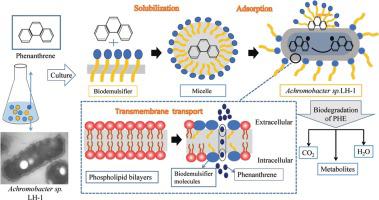Colloids and Surfaces B: Biointerfaces ( IF 5.4 ) Pub Date : 2020-07-09 , DOI: 10.1016/j.colsurfb.2020.111253 Hailian Zang 1 , Yanfei Dai 1 , Yang Sun 1 , Tingting Jia 1 , Qiuying Song 1 , Xianyue Li 1 , Xinxin Jiang 1 , Dongzhe Sui 1 , Ziyi Han 1 , Dapeng Li 1 , Ning Hou 1

|
Biodemulsifiers are widely applied in petroleum processing, mining and petroleum pollution treatment. Polycyclic aromatic hydrocarbons (PAHs) are a common component in petroleum-polluted environments; however, little is known about the mechanism behind the effect of biodemulsifiers on promoting PAH biodegradation. To obtain clear mechanistic insights, the facilitating effects of biodemulsifiers on the bioavailability of phenanthrene (PHE), which is used as a model PAH, and the cell membrane properties of PHE-degrading bacteria Achromobacter sp. LH-1 were researched. The results showed that LH-1 achieved a 96.1 % degradation rate and a 60 % adsorption rate. Biodemulsifiers could encapsulate PHE within micelles to solubilize PHE and increase the cell surface hydrophobicity (CSH) of LH-1 to improve the association of LH-1 with PHE. Furthermore, biodemulsifier molecules can be embedded in the phospholipid bilayer of the LH-1 membrane to increase the permeability and the area of the LH-1 membrane, and they can increase the unsaturated fatty acid contents of the LH-1 membrane to loosen the arrangement of carbon chains, thus further facilitating the uptake of PHE by LH-1 for biodegradation. These results suggest that biodemulsifiers are powerful biological products for increasing the degradation potential of PHE-degrading bacteria in ecosystems, and their application will be important for the economical and efficient bioremediation of PHE-contaminated environments.
中文翻译:

无色杆菌属生物破乳剂增强菲生物降解的机制。LH-1。
生物破乳剂广泛应用于石油加工、采矿和石油污染处理。多环芳烃 (PAH) 是石油污染环境中的常见成分;然而,关于生物破乳剂促进多环芳烃生物降解作用背后的机制知之甚少。为了获得清晰的机理见解,生物破乳剂对用作模型 PAH 的菲 (PHE) 的生物利用度的促进作用以及 PHE 降解细菌无色杆菌的细胞膜特性。研究了 LH-1。结果表明,LH-1实现了96.1%的降解率和60%的吸附率。生物破乳剂可以将 PHE 包裹在胶束中以溶解 PHE 并增加 LH-1 的细胞表面疏水性 (CSH),从而改善 LH-1 与 PHE 的结合。此外,生物破乳剂分子可以嵌入LH-1膜的磷脂双分子层,增加LH-1膜的通透性和面积,增加LH-1膜的不饱和脂肪酸含量,使碳的排列松散链,从而进一步促进 LH-1 吸收 PHE 进行生物降解。这些结果表明,生物破乳剂是增强生态系统中 PHE 降解细菌降解潜力的强大生物产品,它们的应用对于 PHE 污染环境的经济高效生物修复具有重要意义。它们可以增加 LH-1 膜的不饱和脂肪酸含量,使碳链的排列松散,从而进一步促进 LH-1 吸收 PHE 进行生物降解。这些结果表明,生物破乳剂是增强生态系统中 PHE 降解细菌降解潜力的强大生物产品,它们的应用对于 PHE 污染环境的经济高效生物修复具有重要意义。它们可以增加 LH-1 膜的不饱和脂肪酸含量,使碳链的排列松散,从而进一步促进 LH-1 吸收 PHE 进行生物降解。这些结果表明,生物破乳剂是增强生态系统中 PHE 降解细菌降解潜力的强大生物产品,它们的应用对于 PHE 污染环境的经济高效生物修复具有重要意义。











































 京公网安备 11010802027423号
京公网安备 11010802027423号